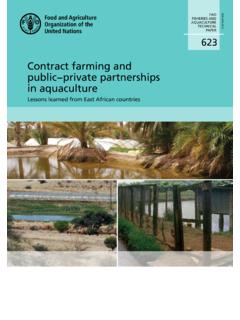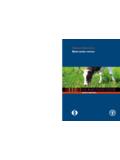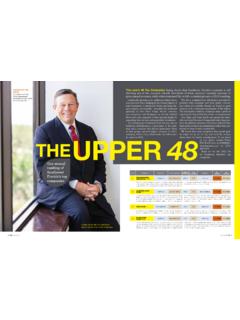Transcription of Commercial farming and agribusiness in South Africa and ...
1 Commercial farming and agribusiness in South Africa and their changing roles in Africa 's agro-food system Ruth Hall and Ben Cousins PLAAS, University of the Western Cape, South Africa International conference Rural transformations and food systems: The BRICS and agrarian change in the global South 20-21 April 2015. BRICS Initiative for Critical Agrarian Studies (BICAS). 1. Introduction Our paper is on Commercial farming and agribusiness in South Africa and their changing roles in Africa 's agro-food system, as a response to debates and theoretical propositions about internal agrarian change in BRICS countries and their relations with other middle-income countries and the old hubs of capital. South Africa is of course an outlier among the BRICS group of countries, given its far smaller economy, and was included only in 2010, as the only candidate that could be seen as economically and politically dominant in Africa though by last year, Nigeria had overtaken South Africa as the largest economy in Africa .
2 BRICS countries as regional hegemons / imperialist / sub-imperialist Adebajo and Landsberg (2003) have argued that South Africa and Nigeria have emerged in the post cold war period as regional hegemons' in Southern and West Africa respectively. But such characterisations hinge on an international relations perspective focusing on states, conflict and diplomacy, rather than our concern here, which is about political economy in relation to agro-food systems in which the state is implicated but not a useful unit of analysis. A related debate is whether South Africa , economically, is an imperial power, or a sub- imperial power in alliance with global capital. We aim to address this, within the BICAS. research agenda, by asking: in what ways have agrarian and agro-food transformations in South Africa itself, located within its economy as a whole, conditioned the manner in which capitals throughout the value chain and associated industries are engaging with the rest of the continent?
3 2. Our argument We present an argument about path dependency. In the context of agrarian change and agro- food transformation, our arugment is not about path dependency in relation to a growth path, but rather in relation to a path of accumulation. South Africa 's economy is centred on what has been termed a mineral-energy complex' as a particular form of capitalism and a system of capital accumulation that underpinned and continues to underpin transformations in the democratic era. Composed of private mining 1. conglomerates and state corporations in electricity and steel, these sectors established a path of development in which a highly developed capitalist economy was constructed in the absence of a substantial manufacturing base a partial vacuum of intermediate and capital goods capability, a failure to accrue economies of scale and scope other than in core MEC. sectors, and an inefficient consumer goods industry surviving by protection upon demand.
4 Agriculture tells a similar, although not identical, story' (Fine 2008: 2). We draw attention to the character of the overall SA economy its transformations and some enduring underpinning features which condition the manner in which South African capitals have been and continue to explore new investment frontiers regionally within Africa and beyond. This character is founded on the contrast between South Africa 's continuing first world corporate capitalism and the third world conditions most citizens live in [which]. are both to a significant extent a product of postapartheid government' rather than, as is often thought, and as much policy thinking presumes, merely a lingering legacy of apartheid (Hart and Padayachee 2013: 56). It is a dualism being produced and reproduced in more profound and entrenched ways, a matter evident in growing inequality even alongside a decline in absolute poverty (ref).
5 One of the persistent features of South Africa 's political economy, under apartheid and under democracy, is the high level of inequality, mirrored in the rising share of income appropriated by the rich', a trend transcending political change (Pons-Vignon and Segatti 2013: 507-509). We locate this within food regime analysis, which characterises historical transformations in where, how and by whom which food is produced, and where, how and by whom which food is consumed. For the purposes of this paper, we attend to where, how and by whom which food is produced by South African people and companies, including the more tangential but perhaps more illuminating question of how South African-connected capital is reshaping food production, processing, retail and consumption in Africa . 3. South Africa 's evolving agrarian structure (BC). History Unlike other societies where capitalist agriculture emerged on the American path of accumulation from below, in South Africa the successful capitalist white farming class was born of state regulation and subsidy, made possible through the minerals revolution.
6 The political economy of the 20th century was shaped by competition between capitals mining, energy, industry and agriculture and from the 1970s the growth of the financial sector, with each deeply embedded in the state through a variety of mechanisms. From the 1913 Natives Land Act to the formalisation of native reserves as Bantustans or homelands', state policy pursued the imperative of making available cheap labour to drive accumulation in the mining, industrial and agricultural sectors. The corollary was a massive programme of state-engineered capitalisation of white Commercial farming , the centrepiece of the National Party's platform of apartheid or apartness' in the 1948 general election, and the construction over time of a complex architecture of state regulation, subsidies, and single- channel marketing of commodities through monopsonistic state control' boards. The financialisation of the 1970s and the economic and political crises of the 1980s set in place dynamics that continue to play out under a liberalised economic regime.
7 2. In the midst of political transition towards democracy, it was not just capital and the state that reached accommodation, but there was also accommodation with labour with real benefits for the narrow stratum of organised labour. At the same time, SA has a distributional regime' of social grants, which provides for a degree of stability in an otherwise untentable situation of inequality. In this sense, South African economic policy cannot be simply described as neoliberal, but the mounting challenge to the state is how to continue to fund this distributional regime in a context of economic stagnation a crisis of accumulation. The continued dominant position of the minerals-energy complex, at the core of South Africa 's economy, has been made possible by the rise of financial capital and financialisation more generally in the economy (Ashman, Fine and Newman 2011). The policy reforms of the 1990s failed to redress the structural imbalance towards the MEC and to broaden ownership of the economy this was not merely a disappointing development failure, but rather represented neoliberal deepening (despite the distributional regime).
8 Here, neoliberalism is understood as policies, ideology and practice which reinforce the power of capital at the expense of labour, and the power of finance capital at the expense of other fractions of capital' and with the active support of the state in the service of capital (Pons-Vignon and Segatti 2013: 509). Deregulation & liberalisation in agriculture The reason why there was real protection and support for agriculture under apartheid, was a significant rural Afrikaner constituency a concern to resolve the poor white problem'. underpinned apartheid policies but became fiscally unsustainable for an apartheid state less dependent on the rural Afrikaner vote and by the 1980s verging on bankruptcy, prompting the start of deregulation and liberalisation (from early 1980s, and more sharply after 1994). Shifts in ownership patterns and production systems (new crops, technologies). The net effects in agriculture were concentration (expansion through internal accumulation).
9 As well as centralisation (buying out competitors), reversing the broad base of white Commercial farming and allowing larger companies to expand operations and landholdings as the number of Commercial farming units dropped precipitously from about 60,000 in 1996 to around 35,000 in 2014. Labour regimes At the same time, despite the introduction for the first time of agricultural labour regulation, in the form of basic labour rights and tenure rights for farm workers and their families living on farms, labour regimes in agriculture have moved towards smaller, more highly-skilled, largely male, on-farm workforces, as changes to production systems and a massive expulsion of labour, led to a massive displacement of farm workers and dwellers possibly 3 million since the start of democracy and an inversion of permanent to temporary workers, with growing casualisation and labour brokering. This has meant the creation of an increasingly off-farm, casual labour force, especially in the core sector of horticulture a footloose workforce of people in informal settlements dotted around farming districts a central feature of what Bernstein refers to a fragmented classes of labour'.
10 Big Food 3. Deregulation, especially the closure of marketing boards and privatisation of sectoral cooperatives, facilitated vertical integration, leading to Big Food' the growing dominance of just a handful of powerful corporations in inputs, processing and retail, and to a lesser degree in primary production alongside financialisation, the key moment in which was the creation of a futures market (SAFEX) in key staple commodities. While financialisation is global, in South Africa it was clearly a response to falling rates of profit, underpinned by liberalisation, and South African capitals responding to a wider set of opportunities and pressures in the global capitalist economy. Competition Commission Contrary to the predictions of the World Bank, whose proposals for Rural Restructuring informed the deregulation plan of the 1990s, these policy reforms neither lowered barriers to entry for small farmers, nor lowered the price of food food price inflation has been far exceeding general inflation, not only due to the widespread collusion and cartels in key sectors notably fertiliser, seed, poultry, milling, bread and retail but due to the concentrated structure of the food system itself, and its industrial farming models premised on input- and capital-intensive production.





